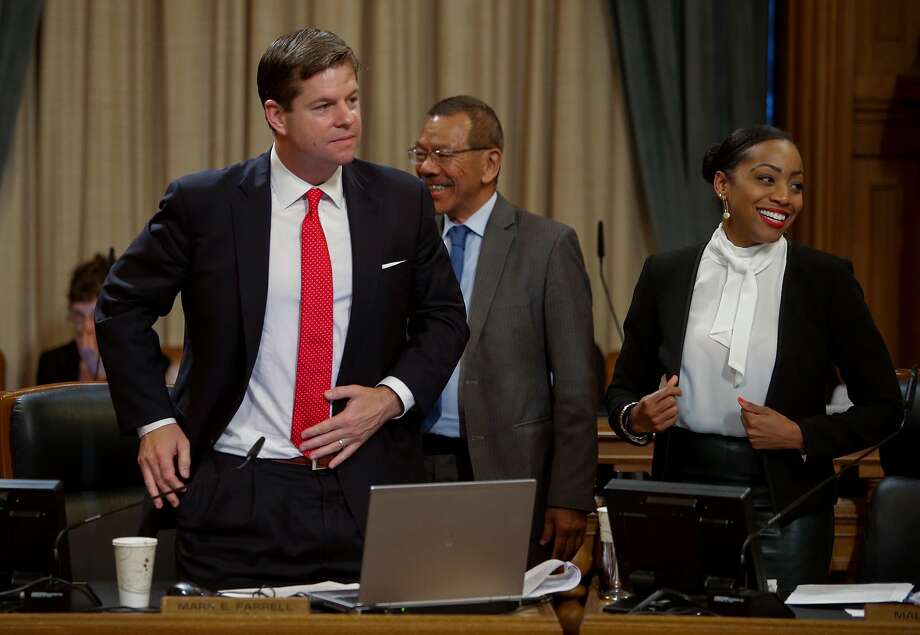SF may ban controversial flame-retardant chemicals
SF may ban controversial flame-retardant chemicals
SF may ban controversial flame-retardant chemicals
By Rachel Swan
July 25, 2017 Updated: July 25, 2017 6:00amSan Francisco is on track to become the first city in the nation to ban flame-retardant chemicals from furniture and children’s products, a move scientists said could bring down cancer rates and save children from a variety of developmental problems.
Supervisor Mark Farrell will introduce the legislation at Tuesday’s Board of Supervisors meeting. He deems it the logical next step for a city that outlawed plastic grocery bags in 2012 and barred polystyrene foam last year.
“San Francisco will always be an environmental leader,” Farrell said, citing research that links the flame-repelling substances to attention problems, lowered IQs, hormone disruption, reproductive issues and cancer. Flame retardants are baked into many household products, including baby strollers, computers, building insulation, plastics and nursing pillows.
These chemicals migrate into dust, posing a danger to infants who crawl around on floors or people who eat at their computers.
Legislators and public health advocates have tried for years to get them banned at the state level but have always run into opposition from chemical manufacturers.
“The chemical industry would lie and cheat,” said former state legislator Mark Leno, who introduced a first anti-flame-retardant bill as a state assemblyman in 2006. Leno, a San Francisco Democrat who is also a former city supervisor, sponsored four such bills over his career in the Assembly and Senate, three of which failed. The only one that passed was a 2015 law requiring furniture labels to indicate whether the product contains flame retardants.

Legislators and public health advocates have tried for years to get them banned at the state level but have always run into opposition from chemical manufacturers. “The chemical industry would lie and cheat,” said former state legislator Mark Leno.
He said chemical-industry lobbyists fiercely fought his legislative efforts, appealing to voters in radio and television ads, robocalls and mailers.
“They urged people to call their legislators and tell them to vote against these bills, because otherwise, ‘Your children will die in a fire,’” Leno said.
He and others trace the state’s problems with flame retardants back to regulations that Gov. Jerry Brown established during his first term in 1975, requiring manufacturers to subject all their products to an open flame test.
The laws were well-intentioned, Leno said, but “pretty much required (these companies) to use chemicals.” He noted that although the law was unique to California, it affected other states because California is the most populous state.
“Because of the size of our marketplace, all furniture sold anywhere in the U.S. had to be made to comply with our regulations,” Leno said.
Brown rewrote those laws in 2013, allowing manufacturers to use fire-resistant fabrics and coverings. But he stopped short of outright banning flame retardants, which are still used in roughly a quarter of all children’s products sold in the nation, according to research by the Oakland-based Center for Environmental Health.
Farrell expects his ban to sail through the Board of Supervisors, though it is already facing criticism from a prominent national trade association.

“Flame retardants provide consumers with a critical layer of fire protection,” said Bryan Goodman, spokesman for the American Chemistry Council’s North American Flame Retardant Alliance. “They also help products meet important fire safety standards that are in place to protect life and property.”
Such reasoning has for decades given consumers a false sense of security, said Suzanne Price, who in 2009 left her job at an investment bank to open an organic baby boutique in San Francisco’s Marina District.
Price has struggled for eight years to stock her shop with alternatives to the chemical-doused polyurethane foam that’s used in many bassinets and crib mattresses.
She avoids those chemicals and instead sells items with naturally occurring flame retardants, such as wool, latex, baking soda and coconut husks. They are expensive and hard to find, Price said, and she has to explain to customers why it’s worth spending an extra $50 on a mattress that won’t emit toxins.
“The conventional wisdom is that if it’s so bad, the government would have banned it,” Price said. “And some people thought they needed chemicals to keep their babies safe from a fire.”
If it passes, Farrell’s ban could have profound effects not just for retailers and consumers, but also for firefighters who may inhale noxious compounds when flame retardants burn.
Blood tests of 12 San Francisco firefighters in 2014 showed that all of them had high levels of dioxins, which are released when the compounds in flame retardants catch fire. Dioxins are extremely carcinogenic, said Tony Stefani, head of the San Francisco Firefighters Cancer Prevention Foundation.
Stefani blames flame retardants for an epidemic of cancer among his colleagues, including breast cancer rates for female San Francisco firefighters that are six times the nation’s average for women 40 to 50 years old. He said these chemicals do “little or nothing” to limit fires, despite manufacturers’ claims.
Rachel Swan is a San Francisco Chronicle staff writer. Email: rswan@sfchronicle.com
Twitter: @rachelswan
San Francisco environmental laws
2006: Plastic-bag ban at large grocery stores and retailers, and foam container ban in restaurants and hotels
2008: Large commercial and residential high-rises required to meet LEED Gold standard
2009: San Francisco residents required to separate recyclable materials, compostable materials and landfill trash
2012: Plastic-bag ban extended to include all retail stores
2013: Plastic-bag ban at all food establishments
2014: Plastic-water-bottle ban on city property
2015: Shift to renewable diesel fuel for city fleet
2 016: Polystyrene ban on everything from packing peanuts to ice chests to to-go coffee cups
2016: San Francisco becomes the first U.S. city to require solar rooftops on new buildings
Swan, Rachel. “SF May Ban Controversial Flame-Retardant Chemicals.” San Francisco Chronicle, 25 July 2017, www.sfchronicle.com/politics/article/SF-may-ban-controversial-flame-retardant-chemicals-11349686.php.
